h2# - Theme: Switchback
Problems: 85
Authors: 34
Problems: 85
Authors: 34
First of all, let me express my heartfelt thanks to all the participants.
Their contributions are a real delight to me. And my special thanks
goes to Kohey Yamada, who successfully directed this tourney.
I started to devote my time and energy to chess problems about ten years ago. At that time, I never dreamed that I could make friends with so many problemists all ower the world. Their everlasting friendship is what sustains me in my activities as a problemist.
The general quality of the entries is fairly good, and I ranked them as follows:
Section A Orthodox
I started to devote my time and energy to chess problems about ten years ago. At that time, I never dreamed that I could make friends with so many problemists all ower the world. Their everlasting friendship is what sustains me in my activities as a problemist.
The general quality of the entries is fairly good, and I ranked them as follows:
Section A Orthodox
|
Jorge Lois
Jorge Kapros 1st Prize |
Michel Caillaud
2nd Prize |
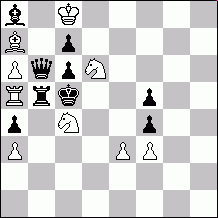
|
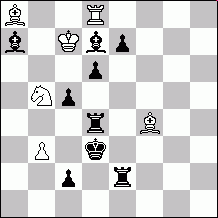
|
|
h2# 9 + 9
|
h2# 6 + 9
|
|
B: Pe3 -> e4
A:1.Kd5 Sxb5 2.Kc5 Sd6# 1.Qxa7 Rxa4 2.Ra5 Rxa5# B: 1.Rxa5 Bb8 2.Qa7 Bxa7# 1.Kd4 Sb6 2.Kc5 Sc4# A fine example of "the Helpmate of the Future" which is currently in fashion, and these four solutions give as a strong sense of unity. The drawback here is that black has not much choice, but perhaps that cannot be helped with this tempo motivation. The joint authors attached the diagram below by Almiro Zarur for comparison. and altough the matrixes certainly look similar, Iagree with their judgement that H02 different solutions and thus can be considered as an original problem. |
B: a1=b1
A:1.Bh3 Bxd6 2.Rg4 Bf4# B: 1.Ra4 Sxe6 2.Bb4 Sc5# A well-known hideaway mechanism, but artistically blended with white's line opening and closing switchbacks, it has an optically pleasing efect. One only wonders it this can be done with fewer pieces ... |
|
Almiro Zarur
Guaratingueta CC 8th TT 1965-66 2nd Prize |
|
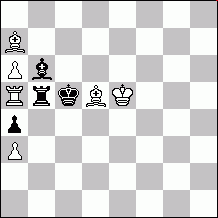
|
|
|
h2# 6 + 4
|
|
|
** 2 solutions
1... Bb8 2.Ba7 Bxa7#1... Rxa4 2.Ra5 Rxa5# 1.Rxa5 Bb8 2.Rb5 Bd6# 1.Bxa7 Rxa4 2.Bb6 Rc4# |
|
|
Michel Caillaud
Special Prize |
Jorge Lois
Jorge Kapros 1st Honourable Mention |
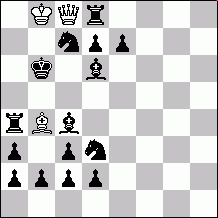
|
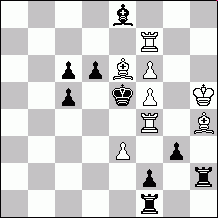
|
|
h2# 3 + 15
|
h2# 8 + 9
|
|
1.Sa6+ Ka8 2.Bb8 Qb7# "Where is switchback?" you may ask, but first let us consider how this position can be attained. Black I's made 13 captures, which explains all captures by black. The only missing black piece is Q. And now, what is white's last move? It cannot be 1.Pb7xQc8=Q so is must be 1.Ka8-b8. After that, the retro play can be easily deducted like this: 1.Sa6-c7+ 2.Pb7xQc8=Q (1.Pc7-c8=Q ? Illegal !) Bb8-d6+ 3.Bd6-b4. So what have we got here? At the first glance, it seems that there is no switchback at all in the solution, but after taking back four half-moves before this position, it turns out that there are actually four switchbaks by four different pieces in the solution!! Totally amazing conception, and it stands out among all the entries in its originality. The only problem for the judge is whether it is classified as an orthodox or a fairy. Taking it as an orthodox may not do justice to other orthodox entries, and I decided to give it Special Prize. Anyway this problem is by far the most original entry in this tourney, and I thank the author for this wonderful birthday present. |
2 solutions
1.Rg2 Bxg3 2.Rh2+ Rh4#1.Bd7 Re7 2.Be8+ Bf7# Many participants tried this unpin mechanism by black, but this one is the best in its graceful setting using only RBPs. In addition white's B/R replacing R/B is a nice embellishment. |
|
Comel Pacurar
2nd Honourable Mention |
Chris J. Feather
3rd Honourable Mention |
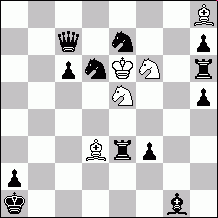
|
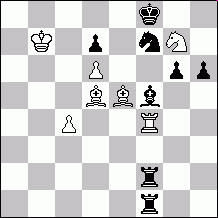
|
|
h2# 5 + 12
|
h2# 7 + 8
|
|
2 solutions
1.Se4 Sg6 2.Sd6+ Se4#1.Sg6 Se4 2.Se7+ Sg6# Here again we have black's unpin move, but this time it is interception instead of withdrawl. The most interesting point is black's second move. Black wants to move Qc7 away and unguard the squares e5/g7, but unfortunately, Q has no decent hideaways. Therefore he needs to shut off the Q-lines by S switchbacks. The symmetry certainly detracts a little, but overall this is a good composition. Umnov effect also leaves a nice aftertaste. |
2 solutions
1.Bg4 Bxf7 2.Bf3+ Bd5#1.Sg5 Sxf5 2.Sf3 Sg7# Black's half-pinned pieces move twice to get behind white's pinning piece (Rf4 in this case). The idea looks new to me, but compared to this, switchbacks by white are rather poorly presented and their unity is imperfect. |
|
Jorge Lois
Jorge Kapros 1st Commendation |
René J. Millour
2nd Commendation |
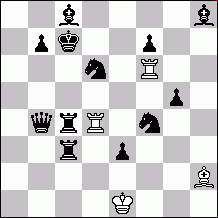
|
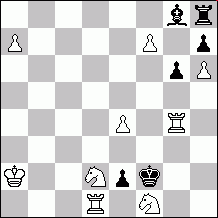
|
|
h2# 4 + 12
|
h2# 9 + 6
|
|
2 solutions
A:B: Pe3 -> c5 1.Se6 Rxd6 2.Sc5 Rd4# 1.Se4 Rxf4 2.Sc5 Rf6# B: 1.Sd5 Rxd6 2.Se3 Rf6# 1.Sf5 Rxf4 2.Se3 Rd4# Again black's half-pinned pieces move twice to arrive the destination squares, but this time, theoretically speaking, two half-moves are not necessarily needed. So there are still further spaces to treat this idea. The symmetry here is too strong and obviously a minus. |
2 solutions
1.e1R fxg8Q 2.Re2 Qf7#1.e1B a8Q 2.Be2 Qa7# Switchback by pawn with promotion can be an interesting idea (for good example, please see Special Prize in this section). Here in this problem, is author exhausts the possibility of such pawn switchbacks in orthodox H#2 (namely, Q/R/B promotions). The effort certainly deserves honorable mention, but it is the great pity that interest lies solely in the realization and we can find no move with attractive motivations. One feels that further investigation is needed in this area. |
|
Jorma Pitkänen
3rd Commendation |
Christer Jonsson
4th Commendation |
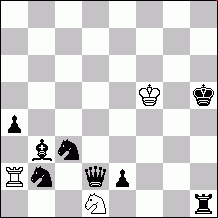
|
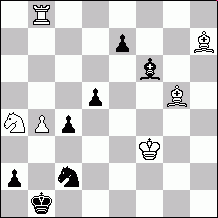
|
|
h2# 3 + 8
|
h2# 6 + 7
|
|
6 solutions
1.Rxd1 Ra1 2.Rh1 Rxh1# 1.Sbxd1 Ra1 2.Sb2 Rxh1# 1.Qxd1 Ra1 2.Qd2 Rxh1# 1.exd1B Ra1 2.Be2 Rxh1# 1.Bxd1 Ra1 2.Bb3 Rxh1# 1.Scxd1 Ra1 2.Sc3 Rxh1# A task six switchbacks. Do I need anything further to add ? |
2 solutions
1.Ba1 Bg8 2.Sxb4 Bh7#1.Bxg5 Rg8 2.Bf6 Rg1# This has absolutely no unity between two solutions except that one has black's switchbacks and another white's. Amazing in a sense. I believe this is a deliberate joke on the part of its author. It makes me wonder... and say under my breath, "To hell with unity!" |
Section B: Fairies
|
Harry Fougiaxis
1st Prize |
Juraj Lörinc
2nd Prize |
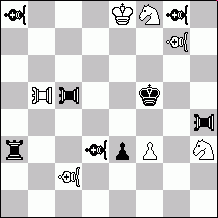
|
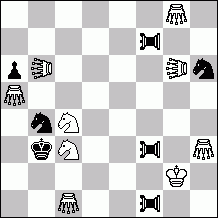
|
|
h2# 7 + 8
|
h2# 9 + 7
|
|
B: a3 R -> B
Rook-Locust 1+2 Bishop-Locust 2+3 A: 1.Ra6 Sg5 2.LRxc2-c1 Sh3# (2... Sge6 ? 3.BLxe6-d5 !) B: 1.Bc1 Sg6 2.LBxb5-a6 Sf8# (2... Sgf4 ? 3.RLxf4-e4 !) Anticipatory line closings with fairy specific blocks on Locust capture squaresa6/c1. White switchbacks mates with fine dual avoidance. Unpins to create white batteries, excanging roles of white's RLb5 BLc2 and black's RLc5/BLd3. Everything is just perfect. A worthy first prize winner. |
B: CGb6 - > b8
A:Grasshopper 4+0 Contra Grasshopper 2+0 Non-stop Equihopper 0+3 1.Sf5 Sd6 2.EQf7-b5 Sc4# B: 1.EQf1-f5 Sd5 2.EQf3-b7 Sc3# This one deserves a good comparison to the first prize winner above. White's first moves unpin NEf7/NEf3 and provide hurdles for them. In their turn. both of black's second moves selfpin Sb4 along the lineCGb6(b8). A fine geometry, and the construction is also superb. In my opinion, the only weakness is in black's first moves. A certain unity is acheived by arrival on the same square f5, that is for sure, but one wishes they have more thematical motivations other than mere unguard and indirect line opening by CGg6. |
|
Michal Dragoun
3rd Prize |
Michal Dragoun
1st Honourable Mention |
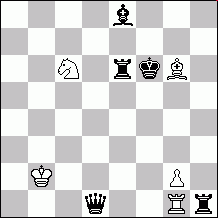
|
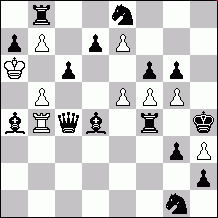
|
|
h2# 5 + 5
|
h2# 8 + 12
|
|
2 solutions
Spiegelcirce 1.Qf3 gxf3 (Qf1) 2.Qxf3 (Pf7) fxe8S (Bf1)# 1.Rh3 gxh3 (Rh1) 2.Rxh3 (Ph7) h8Q# Fairy condition can do wonders. You can achieve what you cannot do in orthodox problems. I think that is what fairies are all about. Here is a good example: blacks switchbacks twice in three half- moves. You might say this is too easy, and I must admit that this has no depth whatever compared to other two prize winners, but the gist of the matter is to dream an impossible dream. Certainly Circe families are a perfect fit for switchbacks. |
B: Ph3 - > h5
A:B: Pg5 - > h5 Anticirce Type Calvet 1.Qxb5 (Qd8) exd8Q (Qd1) 2.Rxf5 (Ra8) Qxd4 (Qd1)# B: 1.Rxf5 (Ra8) bxa8B (Bf1) 2.Bxe5 (Bf8) Bxc4 (Bf1)# C: 1.Bxe5 (Bf8) exf8 (Bc1) 2.Qxb5 (Qd8) Bxf4 (Bc1)# Three pieces QRB along the pin line constitute the black cycle. Although the position is too heavy, this idea is wonderfully realized. My only contention is that switchbacks are too obvious by definition and have no thematic contents. That is exactly why I placed this lower than the third prize winner by the same author in spite of being a better problem. |
|
René J. Millour
2nd Honourable Mention |
Michal Dragoun
Dieter Müller 1st Commendation |
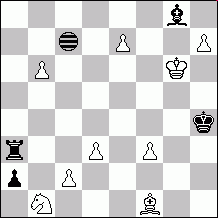
|
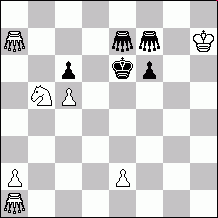
|
|
h2# 9 + 4
|
h2# 7 + 5
|
|
2 solutions
1.a1R (Ic6) hxg8Q (Ib7)Imitator c7 2.R1a2 (Ib8) Qh7 (Ic7)# 1.axb1B (Id6) e8Q (Id7) 2.B1a2 (Ic8) Qe7 (Ic7)# 1.Rb3 (Id7) ? e8Q (Id8) 2.Ra3 (Ic8) Qe7 (Ic7)+ 3.a1Q (Ic6) ! 1.Rb3 (Id7) ? hxg8Q (Ic8) 2.Ra3 (Ib8) Qh7 (Ic7)+ 3.axb1Q (Id6) ! 1.a1Q (Ic6) ? hxg8Q /Ib7) 2.Qa2 (Ib8) Qh7 (Ic7)+ 3.Qxb1 (Id6) ! 1.axb1Q ? (Id6) e8Q (Id7) 2.Qa2 (Ic8) Qe7 (Ic7)+ 3.Qa1 (Ic6) ! Strategic switchbacks with multiple promotions by three pawns. The Imitator on c7 also performs an additional switchback if you consider it as a fairy piece rather than a fairy condition. I appreciate this tremendous effort, but its overall impression is as mechanical as that of construction problems. |
B: Pc6 - > f5
1 0-0 (Kc4-Pd5) dxc6 Castling Chess Grasshopper 2+2 2.0-0 (Ke6-Gd5) Sd4# 1.0-0 (Ke4-Pe5) exf6 2.0-0 (Ke6-Gd5) Sc7# Using Castling Chess, you can have King's hopping switchback. That is about all this problem has in its content. It surely attracts solvers' fancy, but one wants much more. |
|
János Buglos
2nd Commendation |
György Bakcsi
3rd Commendation |
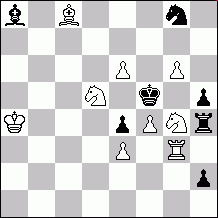
|
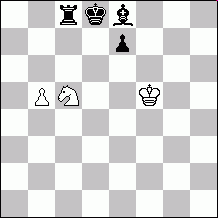
|
|
h2# 9 + 7
|
h2# 3 + 4
|
|
B: Bc8 - > c4
A:Madrasi 1.Kxg6 Sh6+ 2.Kf5 Rxg8# B: 1.Kxe6 Se7+ 2.Kf5 Bxg8# Black king clears the paths for white's RB. Discovered checks secure the place for king's switchbacks by self-paralization. A lovely little affair. |
B: a1=b1
A:Circe 1.Rc6 bxc6 (bRa8) 2.Rc8 Se6# B: 1.Bd6 cxd6 (bBf8) 2.f6+ Sxf6 (bPf7)# Why not? I love the humor of this, and there is no harm in smiling. |